#appium java tutorial
Explore tagged Tumblr posts
Text
Beyond Clicks: Navigating the Landscape of Selenium for Developers
In the dynamic realm of software development, efficiency, and reliability are paramount. Selenium, an open-source framework, has emerged as a powerhouse for automating web browsers and streamlining the testing process. Embracing Selenium's capabilities becomes even more accessible and impactful with Selenium Training in Bangalore. This training equips individuals with the skills and knowledge to harness the full potential of Selenium, enabling them to proficiently navigate web automation challenges and contribute effectively to their respective fields.

Let's dive into the key features and benefits that make Selenium a go-to choice for developers and testers worldwide.
1. Web Browser Automation Simplified
At its core, Selenium is designed to automate web browsers, providing developers and testers with a suite of tools and libraries to script interactions with web elements. From clicking buttons to filling forms, Selenium allows for the programmatic simulation of user actions, significantly enhancing the efficiency of testing processes.
2. Cross-Browser Compatibility at its Core
One of Selenium's standout features is its ability to seamlessly work across different web browsers. Whether it's Chrome, Firefox, Safari, Edge, or others, Selenium ensures that web applications are rigorously tested and perform consistently across various browsers, a crucial aspect in today's diverse online landscape.
3. Versatility Across Programming Languages
Selenium supports a variety of programming languages, including Java, Python, C#, Ruby, and JavaScript. This versatility empowers developers and testers to leverage the language they are most comfortable with, fostering a seamless integration of Selenium into a wide range of development environments.
4. Integration with Testing Frameworks
Selenium effortlessly integrates with popular testing frameworks like JUnit, NUnit, TestNG, and more. This integration facilitates the creation of structured and maintainable test suites, enhancing the organization and execution of tests within the development workflow.
5. Parallel Test Execution for Efficiency
Selenium supports parallel test execution, enabling multiple tests to run simultaneously. This feature is a game-changer, significantly reducing testing time and optimizing resource utilization, especially in scenarios where efficiency is paramount.
6. Headless Browser Testing for Practicality
Selenium's support for headless browser testing allows tests to run without a graphical user interface. This is particularly valuable for scenarios where running a full browser is impractical or unnecessary, providing practical solutions for different testing needs.
7. Mobile Application Automation with Appium Integration
Beyond web applications, Selenium extends its capabilities to automate mobile applications through frameworks like Appium. This holistic approach enables end-to-end testing of both web and mobile applications, creating a unified testing solution.
8. Community Support and Robust Documentation
Selenium boasts a vibrant and active community that contributes to extensive documentation, tutorials, and forums. This community-driven support system ensures that users can easily seek help, share knowledge, and stay updated on the latest developments in Selenium.
9. Seamless Integration with Continuous Integration Tools
Selenium integrates seamlessly with popular Continuous Integration (CI) tools like Jenkins and Travis CI. This compatibility allows for the smooth incorporation of automated testing into the continuous integration and delivery pipelines, aligning with modern development practices.
10. Open Source and Cost-Free Advantage
Perhaps one of Selenium's most compelling features is its open-source nature. Being open source and free to use, Selenium eliminates financial barriers, making it accessible to a broad audience. The collaborative nature of Selenium's community ensures ongoing development and support for its users.
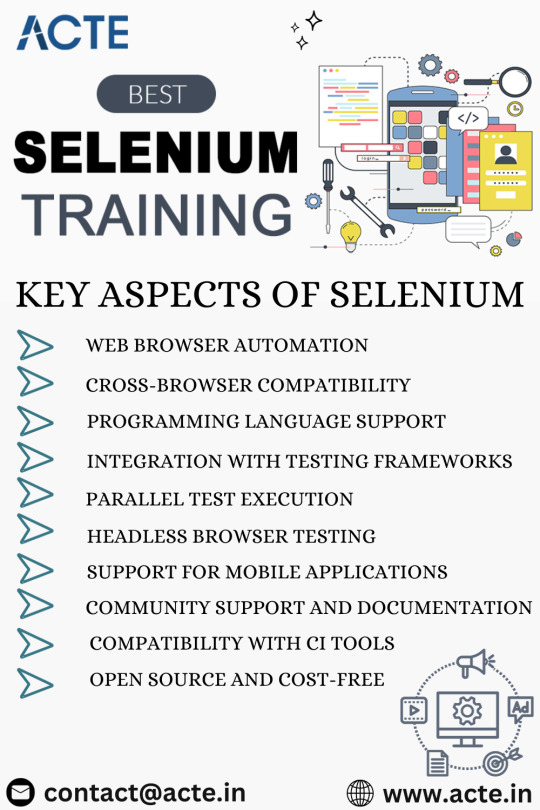
In conclusion, Selenium stands as a powerful and versatile framework that empowers developers and testers to automate web browsers and streamline testing processes. Its cross-browser compatibility, support for multiple programming languages, and integration with testing frameworks make it a cornerstone in the world of web automation. Whether you're a seasoned developer or a testing enthusiast, Selenium's capabilities, coupled with its open-source nature and vibrant community, make it an invaluable tool in the pursuit of efficient and reliable software development. To unlock the full potential of Selenium and master the art of web automation, consider enrolling in the Best Selenium Training Institute. This training ensures that individuals gain comprehensive insights, hands-on experience, and practical skills to excel in the dynamic field of web testing and automation.
3 notes
·
View notes
Text
Benefits and Challenges of Selenium in Automation Testing: A Simple Guide
Selenium is a go-to solution for automating web application testing, thanks to its flexibility and open-source nature. It is widely trusted by developers and testers for its ability to streamline testing processes. However, like any tool, Selenium comes with both benefits and challenges. If you want to advance your career at the Selenium Course in Pune, you need to take a systematic approach and join up for a course that best suits your interests and will greatly expand your learning path. This guide breaks them down simply to help you decide if it suits your testing needs.

Benefits of Selenium
Free and Open Source Selenium is completely free to use, making it accessible for teams of all sizes. There are no licensing fees, allowing teams to get started without worrying about additional costs. For those looking to excel in Selenium, Selenium Online Course is highly suggested. Look for classes that align with your preferred programming language and learning approach.
Supports Multiple Programming Languages With Selenium, you can write test scripts in popular languages like Python, Java, JavaScript, C#, and Ruby. This versatility ensures teams can use the language they are most familiar with.
Cross-Browser Compatibility Selenium allows you to test your applications across various browsers, including Chrome, Firefox, Edge, Safari, and Opera. This ensures consistent functionality for all users, regardless of their browser choice.
Works Across Platforms Selenium supports major operating systems like Windows, macOS, and Linux, offering flexibility in choosing the platform that suits your team’s needs.
Integration-Friendly Selenium integrates seamlessly with tools like Jenkins, Maven, TestNG, and JUnit. This makes it easy to incorporate into your existing workflows and automate testing pipelines effectively.
Strong Community Support Selenium’s active community provides a wealth of resources, from forums and tutorials to troubleshooting guides. This support network simplifies problem-solving and helps new users get up to speed.
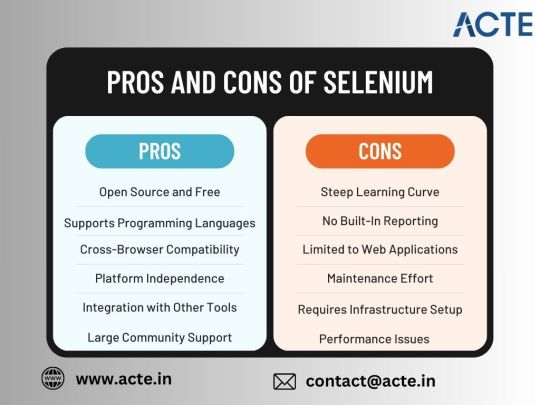
Challenges of Selenium
Learning Curve for Beginners Selenium requires knowledge of programming and web technologies like HTML, CSS, and JavaScript. For beginners, mastering these skills can be time-consuming.
No Built-In Reporting Selenium doesn’t provide native reporting capabilities. To generate comprehensive test reports, you’ll need to rely on third-party tools or libraries.
Limited to Web Testing Selenium is designed specifically for web applications and cannot test desktop or mobile apps directly. For mobile testing, additional tools like Appium are needed.
Script Maintenance As applications evolve, UI changes can break Selenium scripts. Maintaining and updating these scripts can require significant effort, especially in dynamic applications.
Complex Setup for Advanced Features Features like Selenium Grid, which enable parallel testing, require a sophisticated infrastructure setup. This can be resource-intensive and challenging for smaller teams.
Performance Constraints Selenium may experience performance issues with complex test cases or large datasets. Debugging failed tests can also take considerable time.
Selenium is an excellent option for teams seeking a cost-effective and adaptable solution for web application testing. It works best for organizations with skilled testers and developers who can manage its complexities.
For projects that require features beyond Selenium’s core capabilities—like built-in reporting or mobile app testing—teams might need to pair Selenium with complementary tools or explore alternative solutions. By understanding its benefits and challenges, you can determine if Selenium is the right fit for your automation testing strategy.
0 notes
Text
Android App Testing with Appium: A Guide to Automated Testing
Introduction Android App Testing with Appium: A Guide to Automated Testing is a crucial aspect of mobile application development. Appium is an open-source test automation framework for Android and iOS applications. It allows you to write tests in various programming languages, including Java, Python, Ruby, and JavaScript. In this tutorial, we will cover the technical background, implementation…
0 notes
Text
Why should I attempt to learn machine learning and artificial intelligence?
The future and scope for Selenium, particularly in the context of a Selenium course, are promising due to the increasing demand for automated testing in software development. Here’s why learning Selenium and pursuing a career in automation testing can be a valuable investment:
1. Growing Demand for Test Automation
Shift to Agile and DevOps: As companies adopt Agile and DevOps practices, the need for continuous integration and continuous delivery (CI/CD) has risen. Automated testing is a crucial part of these processes, and Selenium is a leading tool for automating web application testing.
Rapid Software Development Cycles: With shorter release cycles and the need for frequent updates, automated testing becomes essential for ensuring quality without delaying the release. Selenium allows for fast and reliable regression testing.
2. Industry-Wide Adoption
Popularity Among Companies: Selenium is widely adopted across industries, including tech giants, startups, and enterprises, due to its open-source nature, flexibility, and support for multiple programming languages and browsers.
Integration with Other Tools: Selenium integrates well with popular CI/CD tools like Jenkins, cloud platforms like AWS, and other testing frameworks, making it a preferred choice for many organizations.
3. Career Opportunities
High Demand for Automation Engineers: There is a strong demand for professionals skilled in Selenium, with job roles such as Automation Test Engineer, QA Engineer, and Test Automation Lead being popular in the market.
Attractive Salaries: Automation testers with Selenium expertise often command higher salaries compared to manual testers, reflecting the value of automation skills in the job market.
4. Evolving Ecosystem
Selenium 4: The release of Selenium 4 brought significant updates, such as a new WebDriver API, improved Selenium Grid, and better integration with other tools. Staying updated with these advancements keeps you relevant in the field.
Support for Modern Web Technologies: Selenium continues to evolve to support the latest web technologies, ensuring it remains a critical tool for web application testing.
5. Cross-Browser and Cross-Platform Testing
Versatility: Selenium supports testing across multiple browsers (Chrome, Firefox, Safari, etc.) and platforms (Windows, macOS, Linux), making it versatile and widely applicable.
Mobile Testing: While Selenium is primarily for web applications, it can be used in conjunction with tools like Appium for mobile testing, expanding its scope further.
6. Learning and Development
Continuous Learning: The scope of Selenium is not limited to just the tool itself. Learning Selenium often involves gaining knowledge in related areas like Java/Python programming, TestNG/JUnit, Continuous Integration, and more, which broadens your skill set.
Community and Resources: Selenium has a vast community of users and developers, providing ample resources, tutorials, and support, which makes it easier to learn and stay updated with new trends.
7. Global Opportunities
Remote Work: With the global shift toward remote work, companies worldwide are looking for automation testers. Having Selenium skills can open up global job opportunities, not just in your local market.
Freelancing and Consulting: Selenium expertise is also valuable in the freelance market. Experienced professionals can offer consulting services, work on short-term projects, or provide training.
8. Integration with AI and Machine Learning
AI-Driven Testing: The future of automated testing includes the integration of AI and machine learning to make testing smarter and more efficient. Selenium is likely to play a role in this evolution, and learning it could provide a foundation for understanding and leveraging AI in testing.
Conclusion
The future and scope for a Selenium course are bright. With the continued growth in the software industry, the adoption of Agile and DevOps methodologies, and the increasing need for efficient and reliable automated testing, Selenium will remain a critical skill for software testers.
AI and machine learning course
full stack course in chennai
0 notes
Text
How Can Java Tutorials Enhance Your Testing Skills?
Introduction to Java for Testers

Getting Started with Appium
Mobile testers can gain a good starting point if beginning with an appium java tutorial in mobile automation. It is an open-source tool that enables testers to automate mobile applications with Android and iOS, ideally remotely. Appium with Java is still preferred as it takes testers through familiar mobile testing constructs. The typical contents of a Java Appium tutorial include the installation procedure, setup, and writing of basic and complex test scripts. Through these tutorials, testers can keep a check and eliminate repetitive activities, enhancing the tests’ efficiency.
Automating with Selenium and Java

Behavior-Driven Development with Cucumber
Behavior-driven development (BDD) has recently become more famous among the testing community, & Cucumber is one of the important tools for BDD. As for the cucumber tutorial for testers, it is necessary to familiarize them with writing the test scenarios in plain language linked to Java. The Cucumber tutorial usually includes feature file creation, step definition creation, and using Cucumber with other testing frameworks. Thus, understanding Cucumber allows testers to facilitate communication between the technical and non-technical sides of the project to align the requirements better.
Manual Testing for Beginners
Automation is essential, but having a good grounding in manual testing is also necessary. An oral presentation of manual testing for a beginner’s tutorial creates a good foundation on the testing life cycle, how to write a test case, identify and track defects, and test management. These tutorials are also helpful in stressing elements such as exploratory testing, usability testing, and customer perspective. A Manual Testing tutorial for beginners assists the testers in paying close attention to every component of an application in the course of testing as a way of pointing out defects that automated testing cannot detect.
Combining Tutorials for Comprehensive Learning
Thus, the tester can develop immense skills using available resources, including Java tutorials for testers, an Appium tutorial in Java, a Cucumber tutorial, and a manual testing tutorial, Basics of Manual Testing. This approach ensures that viewers are familiar with manual and automatic testing. Also, the combination of Selenium with Java interview questions can help the testers stay updated and on the lookout for career promotion opportunities.
Staying Updated and Continuous Learning
Thus, there is a challenge owing to the dynamic nature of the software testing field; the tools and methodologies are constantly developed. Tutorials, practice, and hands-on projects are essential for the students to learn and upgrade themselves continually. Whether beginning his career or seeking an elevated rank, he can benefit significantly from test resources such as Java tutorials for testers, Appium Java tutorials, Cucumber tutorials, and manual testing tutorials for beginners.
0 notes
Text
Automation Testing Demystified: A Beginner's Guide to Getting Started
Starting with automation testing can seem daunting, but understanding the basics can set you on the path to success. Here’s a beginner's guide to demystify the process and help you get started.
Understand Automation Testing: Automation testing uses software tools to execute pre-scripted tests on your application. It helps identify defects, ensures quality, and saves time compared to manual testing. Automation is ideal for repetitive, time-consuming tasks and regression testing.
Identify What to Automate: Begin by selecting test cases that are repetitive, stable, and critical for your application. Focus on high-risk areas, frequent functionalities, and tests that require multiple data sets. Not all tests should be automated; avoid automating tests that are exploratory or infrequently run.
Choose the Right Tools: Selecting the right automation tool is crucial. Popular tools include Selenium for web applications, Appium for mobile apps, and JUnit/TestNG for unit testing. Ensure the tool supports your technology stack and integrates well with your development environment.
Learn the Basics of Scripting: While some tools offer codeless automation, understanding basic scripting can be beneficial. Familiarize yourself with languages like Java, Python, or JavaScript, which are commonly used in automation.
Set Up Your Testing Environment: Configure your testing environment by setting up the necessary tools, libraries, and frameworks. Ensure you have a stable environment that mimics your production setup to get accurate results.
Create and Organize Test Scripts: Start writing simple test scripts and gradually move to more complex scenarios. Organize your scripts using a framework like the Page Object Model (POM) to enhance readability and maintainability.
Integrate with CI/CD Pipelines: Integrate your automated tests into Continuous Integration/Continuous Deployment (CI/CD) pipelines to ensure continuous testing. Tools like Jenkins, GitLab, and CircleCI can help automate the execution of tests with every code change.
Review and Maintain Tests: Regularly review and update your test scripts to accommodate changes in the application. Maintenance is crucial to ensure the reliability and accuracy of your automated tests.
Leverage Community and Resources: Utilize online resources, tutorials, and community forums to enhance your knowledge. Engaging with the community can provide valuable insights and help you troubleshoot issues.
By following this guide, beginners can effectively start with automation testing, improving their QA process and contributing to the delivery of high-quality software products.
#software testing#automation testing#qa testing automation#testing automation tools#test automation solution
0 notes
Text

Explore the essentials of mobile test automation with our comprehensive Appium Tutorial. Learn setup, execution, and best practices for efficient app testing.
0 notes
Text
Your Gateway to Selenium Testing: Start Testing Now with Anyone!
Absolutely anyone can learn Selenium testing! It's an in-demand skill that empowers you to automate repetitive tasks, improve software quality, and free yourself from the monotony of manual testing.
This comprehensive answer will equip you with all the knowledge and resources you need to embark on your Selenium journey, whether you're a complete beginner or a seasoned tester seeking automation proficiency.

Embrace the learning process, and soon you'll be automating tasks like a pro. Best of luck on your Selenium journey! If you ever feel stuck or have questions, the online community is a treasure trove of support.
With dedication, the right resources, and a passion for automation, you can conquer the web with Selenium!- No.1 training for Selenium Courses in Bangalore
1. Grasping the Fundamentals:
Before diving into Selenium's powerful tools, let's solidify your foundation. You'll need a basic understanding of:
Programming: Selenium interacts with web browsers through languages like Python, Java, JavaScript, etc. Familiarity with any of these languages will be your launchpad.
Web Development: Knowing HTML, CSS, and JavaScript will significantly enhance your ability to locate and manipulate web elements using Selenium.
2. Choosing Your Learning Path:
The beauty of learning Selenium lies in its diverse learning avenues. You can tailor your approach to your preferred style and budget:
Self-Guided Learning: Dive deep into the official Selenium documentation, tutorials, and blogs. Websites like "Selenium HQ," "W3Schools," and "TutorialsPoint" offer a treasure trove of free resources, code examples, and interactive exercises.
Structured Courses: Online platforms like Udemy, Coursera, and edX provide comprehensive courses with video lectures, quizzes, and hands-on projects. These offer a more guided approach with structured learning paths and instructor support.
Books: Invest in excellent books like "Selenium WebDriver with Java: A Beginner's Guide" by Bruno Souza or "Selenium WebDriver with Python: A Practical Guide" by Alon Basiya for in-depth knowledge and practical insights.
Communities and Forums: Connect with fellow learners and experienced professionals in online communities like the Selenium Stack Overflow or Reddit forums. Don't hesitate to ask questions, share your progress, and learn from others' experiences.
3. Mastering the Craft:
Once you've grasped the basics, it's time to get your hands dirty with some hands-on practice:
Start small: Begin with simple automation tasks like logging in to a website or filling out a form. Gradually increase complexity as you gain confidence.
Practice consistently: The more you code, the more comfortable you'll become with Selenium's capabilities. Dedicate time daily or weekly to practising and refining your skills.
Embrace challenges: Don't get discouraged by initial hurdles. View them as opportunities to learn and grow. The troubleshooting process itself will solidify your understanding.
Seek help: Remember, you're not alone in this journey. Reach out to online communities, forums, or mentors for guidance and support.
4. Gearing Up for Success:
As you progress, consider these valuable resources to broaden your horizons:
Frameworks: Explore powerful frameworks like Selenium WebDriver or Appium to build robust and scalable test automation frameworks.
Integrations: Learn how to integrate Selenium with other testing tools like JUnit or Pytest for enhanced functionality and reporting.
Open Source Contribution: Give back to the community by contributing to open-source Selenium projects. This is a fantastic way to gain practical experience, collaborate with experts, and boost your portfolio.
5. Remember:
Learning Selenium is a journey, not a destination. Be patient, and persistent, and celebrate your achievements along the way.
The testing landscape is constantly evolving. Stay updated with the latest trends, tools, and best practices to remain competitive.
Automation is not a replacement for manual testing. Both approaches work hand-in-hand for comprehensive software quality assurance.
6. Practice, Practice, Practice:
The more you code, the more confident you become. Practice on demo sites and gradually move to real applications.
7. Online Resources:
Utilize online tutorials, documentation, and forums.
Follow Selenium experts on platforms like Stack Overflow, GitHub, and SeleniumHQ.
8. Version Control:
Familiarize yourself with version control systems like Git. This will help you track changes and collaborate effectively, especially in a team setting.
9. Test Frameworks:
Explore popular testing frameworks like JUnit or TestNG to organize and execute your test cases systematically.
Understand the importance of test suites for efficient testing.
10. Continuous Integration:
Integrate your Selenium tests into a continuous integration (CI) pipeline. Jenkins and Travis CI are popular choices.
Experience in CI ensures your tests run automatically with each code change, maintaining a robust testing environment.
11. Debugging and Logging:
Learn effective debugging techniques to identify and resolve issues in your scripts.
Implement logging to capture essential information during test execution, aiding in troubleshooting.
12. Stay Updated:
Selenium evolves, so stay updated with the latest versions and features.
Join relevant forums and communities to keep abreast of best practices and emerging trends.
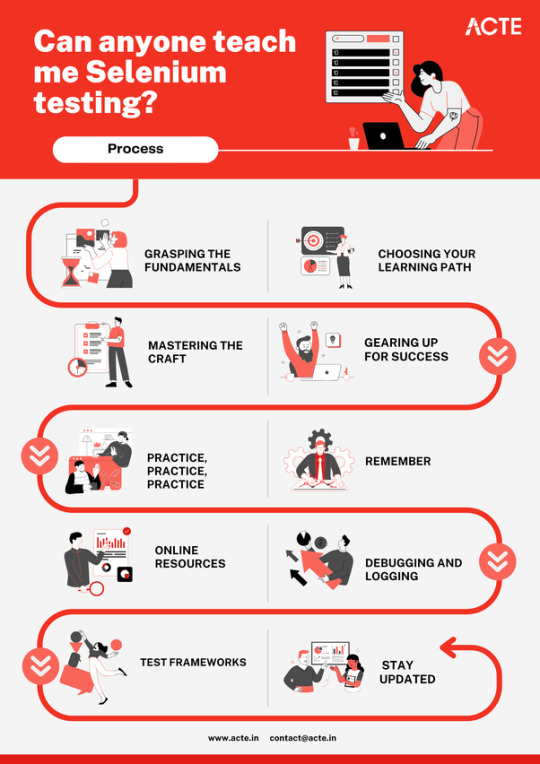
My point is, don't shy away from infusing a bit of fun into your learning journey. Selenium testing isn't just about code; it's about solving real-world problems efficiently. So, don't be afraid to think outside the box and apply what you've learned in unique ways. Remember, the road to Selenium mastery is a thrilling adventure, filled with challenges and triumphs.
Seek programs that offer a recognized certification upon completion. A certification adds credibility to your skills and can positively impact your career prospects. To unlock the full potential of Selenium and master the art of web automation, consider enrolling in the Top Selenium Training Institute
I hope this detailed answer gives you the knowledge and resources to embark on your Selenium testing journey. Remember, the key is to take that first step, keep practising, and never stop learning.
Feel free to ask any further questions, and best of luck in your automation endeavours!
Happy coding!
0 notes
Text
"Selenium for Automation: Streamlining Testing with Open Source Power"
Certainly, I’m excited to delve into the topic of Selenium. My understanding and expertise in this domain have grown considerably over time. Selenium is a widely recognized and extensively used practice across various industries.

Selenium Is a Powerful Tool for Automation, Offering Several Compelling Advantages:
1. Open Source Freedom: Selenium is open source, meaning it’s freely available to everyone. This open nature keeps costs low and encourages a broad user base, making it ideal for small businesses and individual testers.
2. Browser Compatibility: Selenium supports a multitude of browsers, including Chrome, Firefox, Safari, Edge, and more. This compatibility ensures web applications work consistently across various platforms.
3. Programming Language Flexibility: Selenium offers support for multiple programming languages such as Java, Python, C#, and Ruby. This flexibility empowers automation engineers to work with the language they are most comfortable with.
4. Cross-Platform Testing: Selenium enables tests to run on diverse operating systems like Windows, macOS, and Linux. This flexibility makes it an ideal choice for cross-platform testing.
5. Thriving Community and Resources: Selenium’s open-source nature has fostered a thriving user community. This translates to abundant documentation, tutorials, and support forums, making it easy to find help when needed.
6. Seamless Integration: Selenium seamlessly integrates with various tools and frameworks. It can be integrated with testing frameworks like TestNG and JUnit for streamlined test execution and reporting. Integration with CI/CD tools such as Jenkins facilitates continuous integration.
7. Parallel Testing: Selenium excels in parallel test execution, enabling multiple tests to run concurrently. This results in significantly reduced test execution time and an expedited testing process.
8. Scalability: Selenium offers the scalability required to create comprehensive test suites encompassing diverse scenarios. Whether you’re building a custom framework or using existing ones, scalability is within reach.
9. Powerful Web Element Interaction: Selenium provides potent features for interacting with web elements, simulating user actions, and verifying expected behaviors. This functionality is pivotal for effective web application testing.
10. Headless Testing: Selenium’s support for headless browser testing allows tests to run without a graphical user interface. This is especially valuable for continuous integration and faster test execution.
11. Web Scraping Capability: Selenium can be harnessed for web scraping, enabling data extraction from websites for purposes like data analysis, competitor monitoring, and information gathering.
12. Robotic Process Automation (RPA): Beyond web testing, Selenium serves as a valuable tool for automating repetitive tasks that extend into the realm of RPA, streamlining business processes.
13. Community-Driven Extensions: Selenium WebDriver benefits from community extensions and frameworks, including Selenium Grid for parallel testing and Appium for mobile app testing.
14. Vendor-Neutral Adaptability: Selenium isn’t tied to a specific vendor or technology stack, offering the flexibility to adapt to diverse projects and technologies.
15. Booming Career Opportunities: In an era where organizations increasingly rely on web applications, the demand for Selenium testers and automation engineers is burgeoning, creating a wealth of career opportunities.
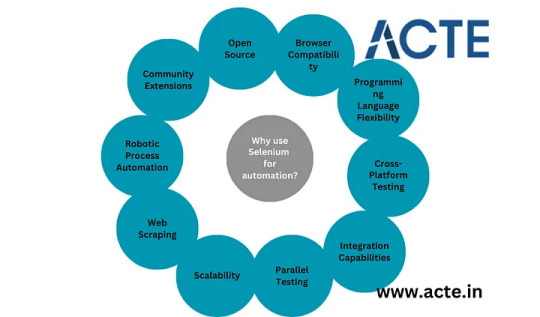
Selenium stands as a versatile and robust tool suitable for web automation, whether you’re an individual tester, a small enterprise, or a large organization. Its open-source foundation, strong community support, and a rich array of features position it as the preferred choice for countless automation projects.
If you’re eager to explore the world of the Selenium Course, I highly recommend considering ACTE Technologies. They offer comprehensive certification programs and job placement opportunities, all guided by seasoned instructors who can enrich your learning journey. These invaluable resources are available both online and in person. Should it align with your interests, a step-by-step approach to considering enrollment in a course could be a beneficial decision.
I trust that this response effectively addresses your query. Should you have further questions or require additional clarification, please don’t hesitate to ask in the comments section.
If you’ve found this response valuable, I cordially invite you to follow me on this platform and express your support with an upvote to encourage further discussions and insights concerning Selenium. Your time and engagement are genuinely appreciated, and I extend my best wishes for an outstanding day ahead.
0 notes
Text
Top 5 Best Software Testing Automation Tools
In the ever-evolving domain of software quality testing, the advent of automated solutions has given birth to a plethora of tools, each contending for the crown of excellence. To navigate this intricate maze of choices, we have meticulously curated a compendium of the top five software testing automation tools, harnessing our profound expertise and insights. These unparalleled instruments not only enhance your automation endeavors but also unleash the true potential of your testing strategies.
Selenium: The Undisputed Apex
Without a doubt, Selenium reigns as the preeminent automated software testing tool, embraced by both web developers and software quality testers. Since its inception in 2004, Selenium has undergone a remarkable metamorphosis, culminating in its present incarnation, which includes various components such as Selenium IDE and Selenium WebDriver. The former, Selenium IDE, serves as a comprehensive integrated development environment for scripting rapid bug reproduction and facilitating automation-aided exploratory testing. On the other hand, Selenium WebDriver boasts language-specific bindings, enabling adept manipulation of browsers to support dynamic web pages. It takes pride in its compatibility with all major web browsers and supports a diverse array of programming languages, such as JavaScript, Java, Ruby, Python, PHP, and C#. While Selenium facilitates automation tests for those with limited programming skills, crafting intricate test scripts demands a higher level of proficiency.
Appium: Empowering the Mobile Frontier
As the mobile app landscape thrives, Appium emerges as a paramount automated software quality testing tool, catering to native, hybrid, and mobile web apps. Taking up the challenge to deliver impeccable applications to discerning consumers, Appium enables mobile app testing without necessitating an SDK or recompilation. Testers wield the power to craft tests using their preferred tools and programming languages, making it a remarkably accessible open-source gem hosted on GitHub. Its versatility shines through in automating extensive regression tests, transforming manual test cases into automated scripts, and beyond. Appium’s duality in supporting both Android and iOS eliminates the need to grapple with distinct languages for each platform, thus conserving valuable time and aligning effortlessly with the requirements of most app developers.
Katalon Studio: The Cross-Platform Virtuoso
Built on the foundations of Selenium and Appium frameworks, Katalon Studio emerges as a cross-platform automation testing solution and software quality assurance. Distinguished by its user-friendly deployment and a thriving community of over 100,000 automation testers, Katalon Studio proves to be a treasure trove of tutorials and guides, simplifying the learning curve. This open-source gem empowers non-programmers to record test scripts, while automation testers proficient in Groovy, Java, or JavaScript can delve into its advanced features. Seamlessly integrating with prominent tools in the QA process and aligning with CI/CD workflows, Katalon Studio delivers unparalleled convenience. For swift installation on Chrome and Firefox, a streamlined version, Katalon Recorder, stands readily available.
Cucumber: Unveiling Behavior Driven Development
Renowned for championing Behavior Driven Development (BDD), Cucumber stands tall as a favored automated software testing tool, optimizing software testing outcomes through crucial acceptance test scenarios during the development process. Initially confined to Ruby testing, Cucumber’s embrace now extends to a plethora of programming languages, such as JavaScript, Java, PHP, and Lua, among others. With its human-readable programming language, Gherkin, Cucumber seeks to define test cases, encouraging BDD practices. It caters to stakeholders prioritizing the end-user experience, actively engaging individuals without coding skills. Being free, easy to set up, and boasting over 30 million downloads, Cucumber proudly holds the title of the world’s most popular automated software testing tool for BDD.
Eggplant Functional: A Paradigm Shift in Testing
Diverging from the conventional object-perspective, Eggplant Functional embarks on an image-based approach to testing, transcending the technology underpinning the tested application and the system it operates on. As one of the finest automated software testing tools, Eggplant Functional forges connections with leading continuous integration and application lifecycle management (ALM) tools, including IBM UrbanCode, Bamboo, HP Application Lifecycle Management, IBM RQM, Jenkins, and more. It boasts an intelligent image recognition method, meriting a patent and securing a privileged position in the market. Eggplant Functional’s accomplishments stand as a testament to its prowess.
Conclusion
In conclusion, the realm of software testing automation thrives on a plethora of sophisticated tools for software testing and DevOps metrics monitoring. Amidst the diverse array of choices, resisting the allure of popularity and hype proves crucial. Instead, prioritize a tool’s alignment with your specific testing strategies. Embracing these exceptional automated software testing tools empowers organizations to flourish in the digital era, delivering unparalleled products and services with unwavering efficiency. As a vanguard in software test automation services and software testing consultancy, SHIFT ASIA – a lead of top software quality assurance companies stands primed to meet your testing needs with unparalleled quality.
0 notes
Text

If you want to be a master of core java for automation testers + interview programs, contact us today
#java#automationtestingforbeginners#javaforautomation#interviewprograms#automationtestingtutorial#corejava#corejavaforautomation#automation
0 notes
Text
Appium Online Training | Best Appium Training Tutorial for Beginners
Best Appium online training Course by our extremely skilled certified trainers. Appium is an open sourse file tool for automating native, mobile web, and hybrid applications on iOS and humanoid platforms. Native apps ar those written mistreatment the iOS, Android, or Windows SDKs. Mobile net apps ar net apps accessed employing a mobile browser (Appium supports campaign on iOS and Chrome or the intrinsical ‘Browser’ app on Android).

Appium Training Tutorial for Beginners is an open sourse software that is employed to automatise applications within the mobile. It permits native, hybrid and net application testing of IOS and humanoid and additionally supports Simulators or Emulators.
youtube
#appium training#appium course#appium online course#appium ios tutorial#appium tutorial#appium tutorial for beginners#appium testing tutorial#appium java tutorial
0 notes
Text
Why should I attempt to learn machine learning and artificial intelligence?
The future and scope for Selenium, particularly in the context of a Selenium course, are promising due to the increasing demand for automated testing in software development. Here’s why learning Selenium and pursuing a career in automation testing can be a valuable investment:
1. Growing Demand for Test Automation
Shift to Agile and DevOps: As companies adopt Agile and DevOps practices, the need for continuous integration and continuous delivery (CI/CD) has risen. Automated testing is a crucial part of these processes, and Selenium is a leading tool for automating web application testing.
Rapid Software Development Cycles: With shorter release cycles and the need for frequent updates, automated testing becomes essential for ensuring quality without delaying the release. Selenium allows for fast and reliable regression testing.
2. Industry-Wide Adoption
Popularity Among Companies: Selenium is widely adopted across industries, including tech giants, startups, and enterprises, due to its open-source nature, flexibility, and support for multiple programming languages and browsers.
Integration with Other Tools: Selenium integrates well with popular CI/CD tools like Jenkins, cloud platforms like AWS, and other testing frameworks, making it a preferred choice for many organizations.
3. Career Opportunities
High Demand for Automation Engineers: There is a strong demand for professionals skilled in Selenium, with job roles such as Automation Test Engineer, QA Engineer, and Test Automation Lead being popular in the market.
Attractive Salaries: Automation testers with Selenium expertise often command higher salaries compared to manual testers, reflecting the value of automation skills in the job market.
4. Evolving Ecosystem
Selenium 4: The release of Selenium 4 brought significant updates, such as a new WebDriver API, improved Selenium Grid, and better integration with other tools. Staying updated with these advancements keeps you relevant in the field.
Support for Modern Web Technologies: Selenium continues to evolve to support the latest web technologies, ensuring it remains a critical tool for web application testing.
5. Cross-Browser and Cross-Platform Testing
Versatility: Selenium supports testing across multiple browsers (Chrome, Firefox, Safari, etc.) and platforms (Windows, macOS, Linux), making it versatile and widely applicable.
Mobile Testing: While Selenium is primarily for web applications, it can be used in conjunction with tools like Appium for mobile testing, expanding its scope further.
6. Learning and Development
Continuous Learning: The scope of Selenium is not limited to just the tool itself. Learning Selenium often involves gaining knowledge in related areas like Java/Python programming, TestNG/JUnit, Continuous Integration, and more, which broadens your skill set.
Community and Resources: Selenium has a vast community of users and developers, providing ample resources, tutorials, and support, which makes it easier to learn and stay updated with new trends.
7. Global Opportunities
Remote Work: With the global shift toward remote work, companies worldwide are looking for automation testers. Having Selenium skills can open up global job opportunities, not just in your local market.
Freelancing and Consulting: Selenium expertise is also valuable in the freelance market. Experienced professionals can offer consulting services, work on short-term projects, or provide training.
8. Integration with AI and Machine Learning
AI-Driven Testing: The future of automated testing includes the integration of AI and machine learning to make testing smarter and more efficient. Selenium is likely to play a role in this evolution, and learning it could provide a foundation for understanding and leveraging AI in testing.
Conclusion
The future and scope for a Selenium course are bright. With the continued growth in the software industry, the adoption of Agile and DevOps methodologies, and the increasing need for efficient and reliable automated testing, Selenium will remain a critical skill for software testers. Learning Selenium not only enhances your career prospects in the present but also positions you for future developments in the field of automation and software testing.
AI and machine learning course
full stack course in chennai
0 notes
Text
20+ Resources for Test Automation Engineers

Test automation is an essential part of the software development lifecycle. It helps teams to deliver high-quality software at a faster pace by automating repetitive tasks and reducing the time and effort needed for manual testing.
However, test automation is a constantly evolving field, and staying up-to-date with the latest tools, technologies, and best practices can be a challenge. To help test automation engineers stay on top of their game, here are 20+ resources that can be valuable for their professional development:
Selenium - An open-source tool for web application testing that supports multiple programming languages.
Appium - An open-source mobile automation testing tool.
TestNG - A testing framework for the Java programming language.
JUnit - A testing framework for the Java programming language.
Cucumber - A tool for behavior-driven development (BDD) that supports multiple programming languages.
PyTest - A testing framework for the Python programming language.
Robot Framework - A generic test automation framework that supports multiple programming languages.
TestComplete - A commercial tool for desktop, mobile, and web application testing.
SoapUI - An open-source tool for testing web services and APIs.
Postman - A commercial tool for testing web services and APIs.
JMeter - An open-source tool for load and performance testing.
Gatling - An open-source tool for load and performance testing.
Apache Kafka - A distributed streaming platform used for building real-time data pipelines and streaming applications.
Apache Storm - A distributed real-time computation system used for processing large streams of data.
Apache Flink - An open-source framework for distributed stream and batch data processing.
Apache Spark - An open-source big data processing framework that supports batch processing, streaming, machine learning, and graph processing.
Machine Learning Mastery - A website that provides tutorials, courses, and resources for machine learning and artificial intelligence.
TensorFlow - An open-source software library for dataflow and differentiable programming used for machine learning and artificial intelligence.
Keras - An open-source software library for deep learning that runs on top of TensorFlow.
The Testing Planet - A magazine dedicated to software testing that provides articles, tutorials, and industry news.
Ministry of Testing - A community-driven website that provides resources, training, and events for software testing professionals.
Software Testing Help - A website that provides tutorials, articles, and tools for software testing and quality assurance.
LinkedIn Learning - An online learning platform that provides courses on software testing, test automation, and other related topics.
In conclusion, test automation is a complex and constantly evolving field, and staying up-to-date with the latest tools, technologies, and best practices is crucial for success. The resources listed above can provide valuable support and guidance for test automation engineers at every stage of their professional development.
1 note
·
View note
Text
Best Automated Software Testing Tools
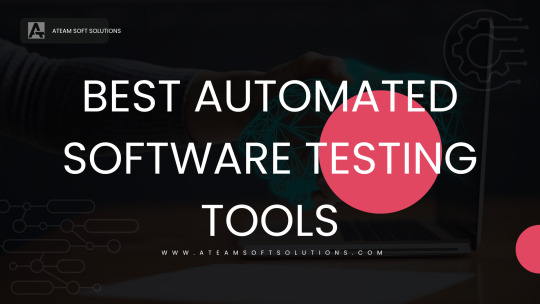
Best Automated Software Testing Tools
Introduction
To deliver successful products and services at the pace demanded by today’s digital economy, software developers can’t afford to rely on anything less than the latest software development practices. According to the most recent edition of the World Quality Report, test automation, the use of special software to control the execution of tests, is helping organizations speed up their decision making to deliver better products in a shorter time.
Also Read – Best Mobile Application Development Company
Best Automated Software Testing Tools
The increased reliance on test automation has resulted in the emergence of a large number of automated software testing tools, making it difficult to decide which of them are the best. To help you with your automation efforts, we have created this list of the top 5 best automated software testing tools based on our own experience and that of others.
Selenium
Selenium is arguably the most popular automated software testing tool among web developers and testers. It was first released in 2004, and it has evolved considerably since then. The latest version of Selenium consists of several components, including Selenium IDE and Selenium WebDriver.
Selenium IDE is a complete integrated development environment (IDE) for Selenium tests, and it’s used primarily for creating quick bug reproduction scripts and scripts to help in automation-aided exploratory testing. On the other hand, Selenium WebDriver is a collection of language-specific bindings to drive a browser, and it was developed to better support dynamic web pages.
Appium
Appium is an automated software testing tool for use with native, hybrid, and mobile web apps. With mobile apps on the rise and major app stores becoming increasingly competitive, there is an urgent need to deliver only quality apps to the consumer.
The goal of Appium is to automate mobile app testing without an SDK or recompilation. Appium allows testers to write test using their favorite tools and programming languages. Getting started with Appium could hardly be any easier, and this remarkable automated software testing tool is open source and hosted publicly on GitHub.
Also Read – Experienced Web Application or Website Development Company
Katalon Studio
Katalon Studio is a cross-platform automation testing solution built on top of the Selenium and Appium frameworks. It’s completely free, easy to deploy, and its active community of over 100,000 automation testers has created a wealth of tutorials and guides that make learning how to use Katalon Studio effortless.
Non-programmers can use Katalon Studio to record test scripts, while automation testers with some programming knowledge can explore some of the more advanced features of Katalon Studio and create powerful automation scripts using Groove, Java, or JavaScript.
Cucumber
Cucumber is a popular automated software testing tool that supports Behavior Driven Development (BDD), which is a software development process that implements important acceptance test scenarios while development is in progress in order to help organizations get most out of software
While Cucumber was originally used exclusively for Ruby testing, it now supports a variety of different programming languages through various implementations, including JavaScript, Java, PHP, and Lua. Cucumber also features its own programming language, called Gherkin. Used to define test cases, Gherkin was designed to be human-readable, and its purpose is to promote BDD practices.
Eggplant Functional
Eggplant Functional was conceived by Doug Simons, Jonathan Gillaspie, and John McIntosh and first released in 2002 by Redstone Software. Unlike other automated software testing tools on this list, Eggplant Functional uses an image-based approach to testing, as opposed to looking at the tested application from the object perspective. This means that the technology used to build the tested application is irrelevant, as is the system on which the application runs.
Eggplant is one of the best Automated software testing tools.
Plug-ins for some of the most popular continuous integration and application lifecycle management (ALM) tools are available, including IBM UrbanCode, Bamboo, HP Application Lifecycle Management, IBM RQM, and Jenkins, among others. Because Eggplant Functional has secured a patent for its intelligent image recognition method, it has been able to enjoy a somewhat privileged position on the market, but its accomplishments stand on their own.
Also Read – Leading Software Development company
#Top Web Developers in Texas#Top Web Development Companies Texas#Web Development Company Texas#web development agency in texas#hire best web developers in texas#Mobile app development agency austin#mobile app development service austin#app developers in austin#app development company austin#austin mobile app development service#software development company dallas#software companies in dallas#dallas software companies#software companies dallas tx#custom software development dallas#best software companies in dallas
0 notes
Text
Tutorial appium android

TUTORIAL APPIUM ANDROID DRIVER
TUTORIAL APPIUM ANDROID FULL
TUTORIAL APPIUM ANDROID ANDROID
You need to edit the run configuration so that your test runs with testNG We need to comment Junit dependencies so that your program does not run the default configuration of Junit, you could easily observe the decencies required in the form of jar files through my current adle. We need to configure testing by committing a few changes in adle file.
TUTORIAL APPIUM ANDROID ANDROID
Junit is configured as default by android studio. We need to perform a bit changes in adle file. Just follow the three-step process defined in below image to add external library files to your project in android studio. These jar files are easily available over the internet. Let me tell you the jars you need to add apart from selenium jar files. We need to paste all jar file except selenium standalone server. You could find the folder named as libs inside the folder named as the app. We need to add the jar files to our Android project. Create a project in Android Studio and follow the basic tricks one after another. To start with Appium we should understand with pre-requisites required for setup. Set Java Home & Android Home from environment variable if it is not configured.Īppium Test Case for Native Android App (Calculator): The selenium jar file can be downloaded from Ĥ. Once we go through the blog things will be defined more precisely but first, we should configure Appium & android at our local machine.ġ. This blog will let you configure the Appium over android studio using a testNG framework. The same WebDriver binding can be used across web and mobile and it supports software test automation on Emulator or Simulator and Physical devices too. This provides code reusability between iOS, Android and Windows test suites.Īppium enables Android and iOS automation using Selenium WebDriver. It provides the cross-platform and writes tests in multiple platforms like iOS, Android, Windows using with the same APIs. It is freely distributed open source mobile application and supports Native, Hybrid and Web application testing and provide automation test support to physical devices as well as emulator or simulator both.
TUTORIAL APPIUM ANDROID DRIVER
You can write your tests with your favorite developer tools using all the programming languages and probably with the Selenium Web Driver API and language-specific client libraries.
TUTORIAL APPIUM ANDROID FULL
I assume you might have at least basic knowledge of Appium.Īppium goals to automate any mobile application from any languages like Ruby, Python, Java, JavaScript, PHP, C# and any test framework, with full access to back-end APIs and DBs from the test code. Users can understand how testNG annotation can be used in test scripts if you’re interested in Appium, how it works and how it is automated to the mobile app then this topic just state the basics of these concepts. Now this time we have come with the more technical aspect of the configuration of Appium with android studio. We already have an article on Appium with eclipse. This article is targeted to the uses who wish to configure mobile automation testing with android studio.

0 notes